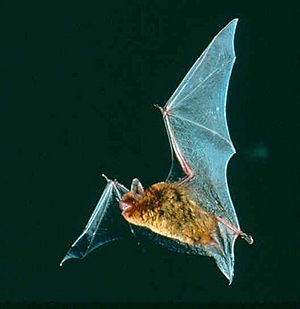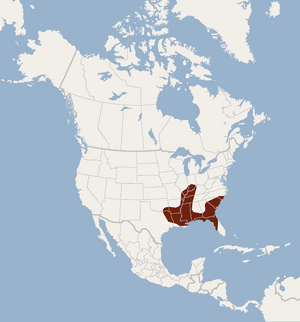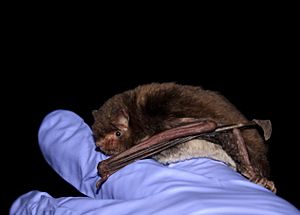Southeastern myotis facts for kids
Quick facts for kids Southeastern myotis |
|
|---|---|
 |
|
| Conservation status | |
| Scientific classification | |
 |
|
| Distribution of the southeastern bat (1989) |
The southeastern myotis (Myotis austroriparius) is a small bat that lives in the southeastern United States. You can find it along the Gulf Coast and near the lower Mississippi River.
Contents
About the Southeastern Myotis Bat
This bat is quite small, weighing only about 5 to 8 grams. That's like the weight of a few paper clips! It mainly eats insects.
Like other bats in its family (called Myotis), the southeastern myotis rests during the day. It comes out to hunt for food at night. These bats often fly and eat over water. They usually fly around, catch insects, and then stop to rest and digest their meal.
Size and Appearance
The southeastern myotis has a wingspan of about 9 to 11 inches. Its fur can be gray or a bright orange-brown. Female bats usually have brighter colors than males.
Unique Bat Babies
Most female Myotis bats have one baby at a time. But the southeastern myotis is special because it often has twins! Sometimes, these bats are seen resting with other bats, like Rafinesque's big-eared bats.
Where Southeastern Myotis Live
These bats live in many parts of the southeastern United States. Their home range includes:
- Southern Illinois and Indiana
- Western parts of Oklahoma, Tennessee, Arkansas, and northeastern Texas
- Eastern areas reaching into southern North Carolina
There are also some groups of these bats living separately in the Ohio River Valley in Kentucky. Most of the bats live in the northern part of Florida.
What Southeastern Myotis Eat
The southeastern myotis mainly eats insects, especially a type called caddisflies. Unlike some other bats that eat many different kinds of bugs, this bat's diet is not as varied. They don't eat many spiders or beetles. Their diet is most similar to the eastern pipistrelle bat because they both eat a lot of caddisflies.
Southeastern Myotis Homes
These bats love to live and hunt near water in forests, especially in what are called bottomland hardwood forests. These forests often have bald cypress and water tupelo trees, which are great places for bats to roost.
Roosting Spots
Southeastern myotis bats need trees that are big and old enough to have holes or cavities where they can live. They also roost in other places like:
- Caves
- Old wells (cisterns)
- Abandoned buildings
- Under bridges
They often choose smaller trees to roost in and like to huddle together in tight groups inside the tree cavities.
Protecting the Southeastern Myotis
The U.S. Fish and Wildlife Service is keeping an eye on the southeastern myotis because its habitat is shrinking. The bottomland hardwood forests where these bats live have lost a lot of land. It's estimated that only 15-25% of these forest wetlands are left compared to how much there used to be.
Challenges They Face
- Habitat Loss: Many of their forest homes have been cleared, often for farming.
- Flooding: Because they live near water, floods can be a problem. Big floods can harm baby bats or reduce the number of insects they can eat.
- Logging: While some logging might leave roosting trees, it can still disturb the bats and their homes.
Scientists and conservationists are working to protect these important bats and their unique forest homes.
See also
 In Spanish: Myotis austroriparius para niños
In Spanish: Myotis austroriparius para niños




